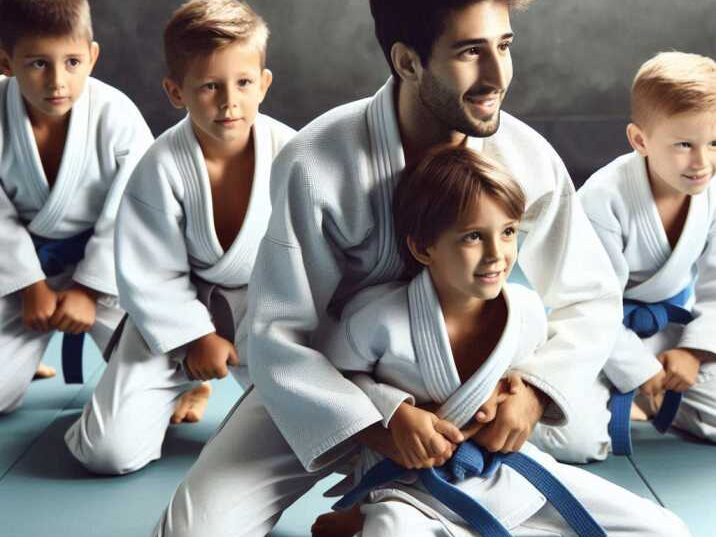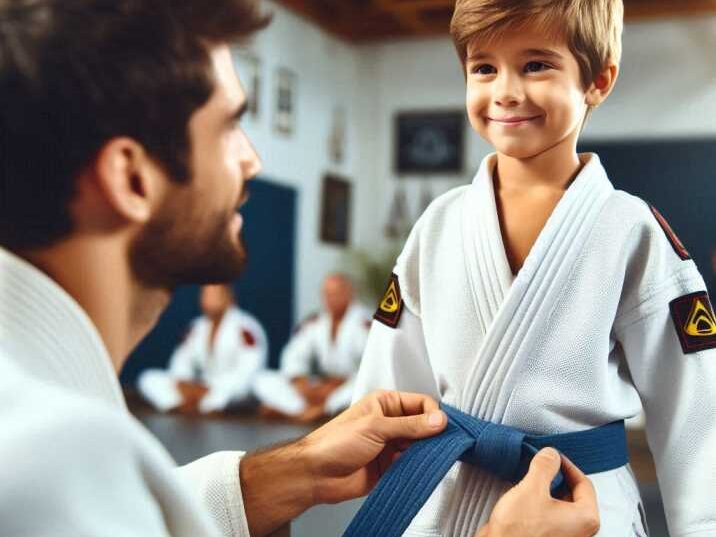Introduction
Table of Contents
Brazilian Jiu-Jitsu (BJJ) is a martial art that emphasizes grappling, ground fighting, and submission holds. But did you know that it’s not just for adults? Kids can benefit immensely from learning Brazilian Jiu-Jitsu, gaining skills that go beyond self-defense. From boosting confidence to improving physical fitness, BJJ offers numerous advantages for young learners. In this article, we’ll explore everything you need to know about Brazilian Jiu-Jitsu for kids, from its benefits to what you can expect in a class.

What is Brazilian Jiu-Jitsu?
Brazilian Jiu-Jitsu is a martial art that focuses on controlling an opponent through techniques such as joint locks, chokes, and pins. Unlike other martial arts that rely on strikes, BJJ uses leverage and technique to overpower an opponent, making it an excellent choice for kids of all sizes and strengths. Kids learn to use their bodies efficiently, making this martial art more about strategy than brute force.
Why is Brazilian Jiu-Jitsu Good for Kids?
1. Boosts Confidence and Self-Esteem
Brazilian Jiu-Jitsu is a martial art that encourages personal growth through skill development and progression. As kids learn new techniques and advance through the belt system, they gain a sense of accomplishment. The structured nature of BJJ, with clear goals and milestones, helps kids build confidence. For example, earning a stripe or a new belt signifies their hard work and dedication, boosting their self-esteem. This newfound confidence often translates into other areas of life, such as school and social interactions, making kids feel more capable and secure in their abilities.
2. Teaches Discipline and Focus
In Brazilian Jiu-Jitsu classes, discipline is a key element. Kids are taught to listen carefully to their instructors, follow instructions, and maintain focus during training. The structured environment of BJJ helps kids develop these habits, which are essential for success both on and off the mats. For instance, mastering a complex technique requires concentration and practice, teaching kids the importance of persistence and self-control. Over time, the discipline learned in BJJ can improve their behavior and focus in school, at home, and in other activities.
3. Improves Physical Fitness
Brazilian Jiu-Jitsu is an excellent way for kids to stay active and healthy. Unlike traditional sports that may focus on specific muscle groups, BJJ provides a full-body workout. Through practicing various techniques, kids enhance their strength, flexibility, and endurance. Rolling (sparring) and drilling improve cardiovascular fitness, helping kids become stronger and more agile. Additionally, BJJ promotes a balanced fitness routine, as it includes both aerobic and anaerobic exercises, making it a great option for improving overall health and physical well-being.
4. Encourages Problem-Solving Skills
Brazilian Jiu-Jitsu is often compared to a game of chess because it requires strategic thinking and problem-solving. In BJJ, kids learn to anticipate their opponent’s moves and develop counters, teaching them to think critically under pressure. For example, if an opponent attempts a sweep, a child must quickly decide how to defend and transition to a more favorable position. This mental agility sharpens their problem-solving skills, which can be beneficial in school and daily life. BJJ teaches kids that quick thinking and adaptability are essential for success.
5. Promotes Social Skills
In a Brazilian Jiu-Jitsu class, kids interact with peers and instructors in a supportive environment. They learn to cooperate, communicate, and respect others, which enhances their social skills. BJJ classes often involve partner drills and group activities, encouraging kids to work together and form friendships. For shy or introverted children, BJJ provides a safe space to build confidence in social settings. The camaraderie and sense of community within the BJJ school help kids develop positive relationships and improve their ability to interact with others.
What to Expect in a Brazilian Jiu-Jitsu Class for Kids
1. Warm-Up and Stretching
Every Brazilian Jiu-Jitsu class for kids begins with a warm-up session. This typically includes exercises like running, jumping jacks, and dynamic stretching. The warm-up is essential because it prepares the body for the more intense activities to come. For young kids, it also helps them get into the right mindset for training. Stretching is particularly important as it increases flexibility, reduces the risk of injury, and ensures that their muscles are ready for the various movements they’ll perform during the class. The warm-up also gets the kids energized and excited to start practicing.
2. Learning Techniques
After the warm-up, the class transitions into learning specific Brazilian Jiu-Jitsu techniques. Instructors introduce a variety of moves, such as guard positions, sweeps, and submissions. These techniques are taught in a step-by-step manner, ensuring that the kids can follow along and understand each movement. Instructors often demonstrate the technique multiple times, allowing the kids to see it from different angles. This hands-on learning approach helps the children grasp the fundamentals of BJJ, and the repetition helps reinforce the techniques in their muscle memory. The techniques taught are usually age-appropriate and gradually increase in complexity as the kids progress.
3. Drills and Sparring
Once the kids have learned the techniques, they practice them through drills. Drills are repetitive exercises designed to ingrain the techniques into the students’ muscle memory. For example, kids may practice a sweep move repeatedly until it becomes second nature. After the drills, the class may move on to sparring, which in Brazilian Jiu-Jitsu is called “rolling.” During sparring, kids pair up and engage in controlled practice matches where they apply the techniques they’ve learned. Sparring is conducted in a safe and supervised environment, allowing kids to experiment with different strategies and learn from real-time feedback. It’s a fun and dynamic part of the class that helps build confidence and improve skills.
4. Cool Down
At the end of the class, the kids go through a cool-down session. This involves gentle stretching and breathing exercises to help their bodies recover from the physical activity. The cool-down is crucial for preventing injuries, as it helps relax the muscles and reduce stiffness. Additionally, this is a time for the kids to reflect on what they’ve learned during the class. Instructors often use this moment to review the techniques and provide encouragement, reinforcing the progress the kids have made. The cool-down session leaves the children feeling accomplished and ready for the next class.
How to Choose a Brazilian Jiu-Jitsu School for Your Child
1. Qualified Instructors
Look for schools with experienced instructors who specialize in teaching kids. They should be patient, encouraging, and able to communicate effectively with young learners.
2. Child-Friendly Environment
The atmosphere should be welcoming and supportive. The school should emphasize safety and ensure that the kids are comfortable and having fun.
3. Curriculum
Check if the school has a structured curriculum that progresses your child through different levels. A well-planned curriculum helps kids stay motivated and focused on their goals.
4. Class Size
Smaller class sizes allow for more personalized attention. Your child will benefit from one-on-one instruction, which can accelerate their learning.
5. Trial Classes
Many BJJ schools offer trial classes. Take advantage of these opportunities to see if the environment is a good fit for your child before committing.
Age and Belt Progression in Brazilian Jiu-Jitsu for Kids
1. Age Groups
- Tiny Champions (4-6 years old): This age group focuses on basic movements and coordination.
- Juniors (7-10 years old): Kids start learning more complex techniques and engage in light sparring.
- Teens (11-15 years old): At this stage, students refine their techniques and participate in regular sparring sessions.
2. Belt System
Kids progress through a belt system that starts with white and goes up to black. Each belt has stripes, indicating the child’s progress within that level. The belt system helps keep kids motivated and provides clear goals.

Common Concerns for Parents
1. Is Brazilian Jiu-Jitsu Safe for Kids?
Yes, Brazilian Jiu-Jitsu is safe when practiced under the supervision of qualified instructors. Safety is a top priority in BJJ classes, and kids are taught how to execute techniques correctly to avoid injuries.
2. What If My Child Is Shy or Introverted?
BJJ is excellent for shy kids as it helps build confidence and social skills. Instructors are trained to make shy children feel comfortable and gradually encourage them to participate more actively.
3. How Often Should My Child Train?
Two to three times a week is ideal for most kids. This allows them to improve their skills without feeling overwhelmed.
4. Will My Child Get Hurt?
While there is always a risk of injury in any sport, BJJ is generally safe for kids. Instructors emphasize technique over force, and sparring is closely monitored to ensure safety.
5. How Long Does It Take to Earn a Belt?
Belt progression varies depending on the school and the child’s dedication. On average, it takes about 1-2 years to move from a white belt to the next level.
Brazilian Jiu-Jitsu Tournaments for Kids
Participating in tournaments can be a valuable experience in Brazilian Jiu-Jitsu for kids. These events allow them to test their skills against other children in a controlled and safe environment. Competing helps build resilience, sportsmanship, and a deeper understanding of the martial art.
Table of Information about Brazilian Jiu-Jitsu for kids
| Aspect | Details |
|---|---|
| Starting Age | 4 years old |
| Class Frequency | 2-3 times per week |
| Safety Level | High (under qualified instructors) |
| Common Techniques | Guard positions, sweeps, submissions |
| Benefits | Confidence, discipline, fitness, social skills |
| Belt Progression | White to black with stripes |
Conclusion
Brazilian Jiu-Jitsu for kids is an excellent martial art, offering a range of physical, mental, and social benefits. From boosting confidence to improving fitness, BJJ equips kids with skills that will serve them well in all areas of life. If you’re considering enrolling your child in Brazilian Jiu-Jitsu, look for a school with qualified instructors, a structured curriculum, and a welcoming environment. With dedication and practice, your child will not only learn self-defense but also gain valuable life skills.
5 FAQs about Brazilian Jiu-Jitsu for Kids
- Q. What age can kids start Brazilian Jiu-Jitsu?
- Kids can start Brazilian Jiu-Jitsu as young as 4 years old, focusing on basic movements and coordination.
- Q. How often should kids train in Brazilian Jiu-Jitsu?
- Training 2-3 times a week is ideal for kids, allowing them to improve their skills while balancing other activities.
- Q. Is Brazilian Jiu-Jitsu safe for children?
- Yes, BJJ is generally safe for kids when practiced under the supervision of qualified instructors.
- Q. Will Brazilian Jiu-Jitsu help my child build confidence?
- Absolutely! Brazilian Jiu-Jitsu teaches kids new skills and helps them progress through belt ranks, boosting their confidence.
- Q. Can shy kids benefit from Brazilian Jiu-Jitsu?
- Yes, BJJ helps shy kids develop social skills and confidence through interaction and teamwork.


